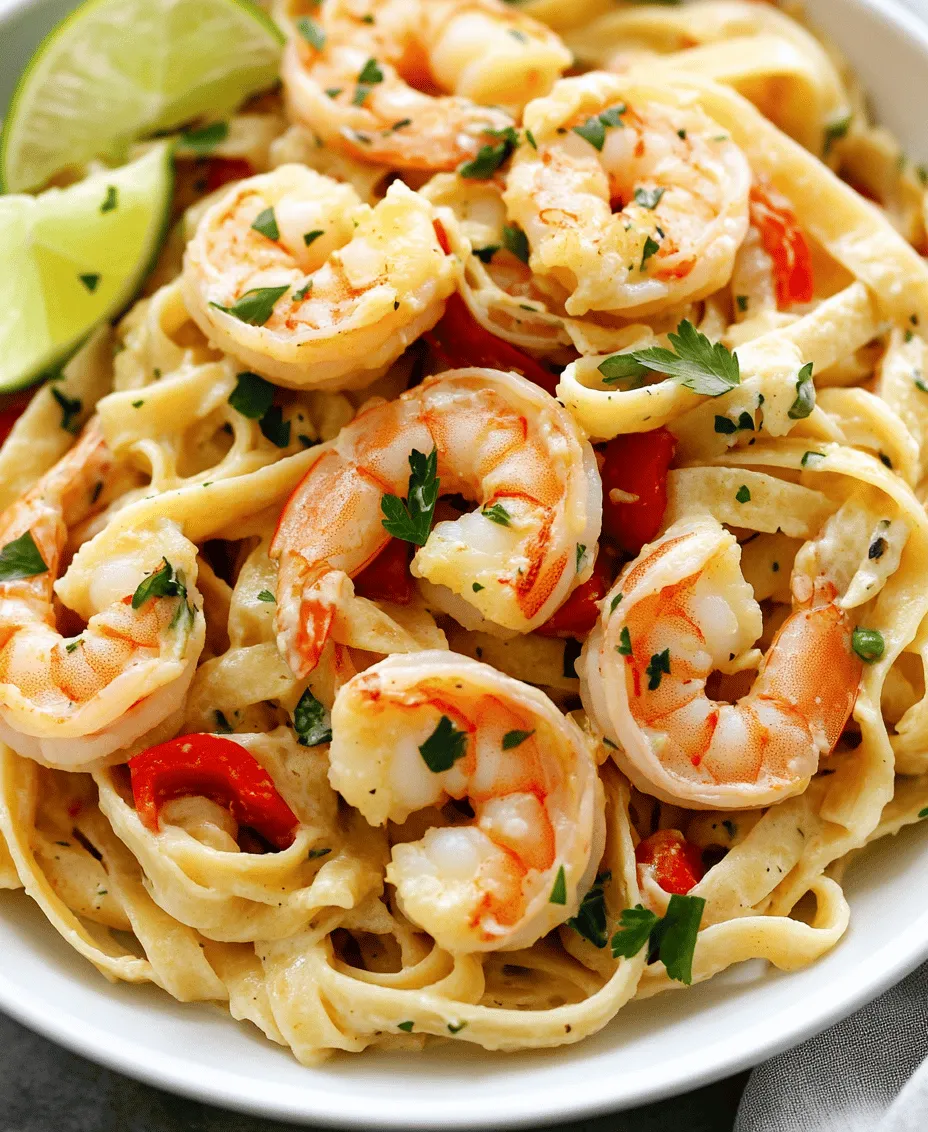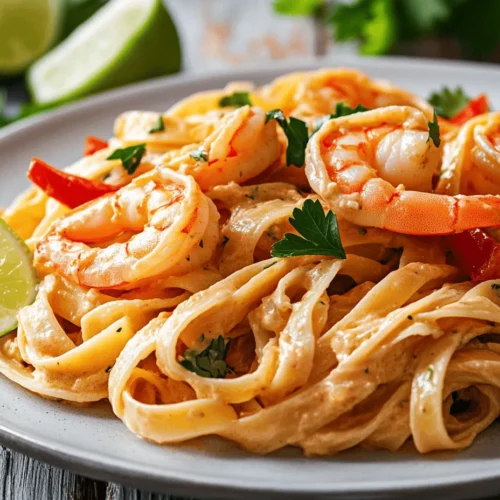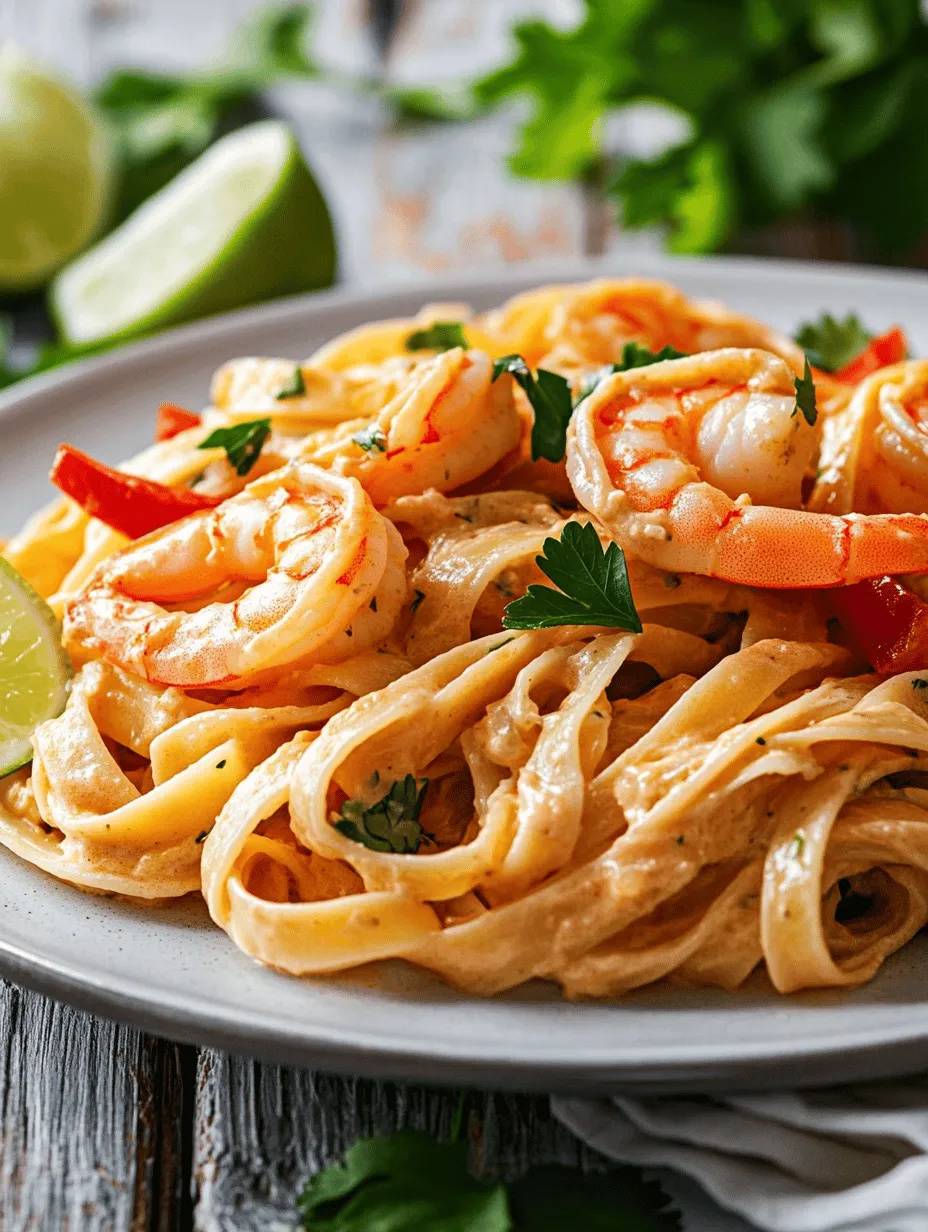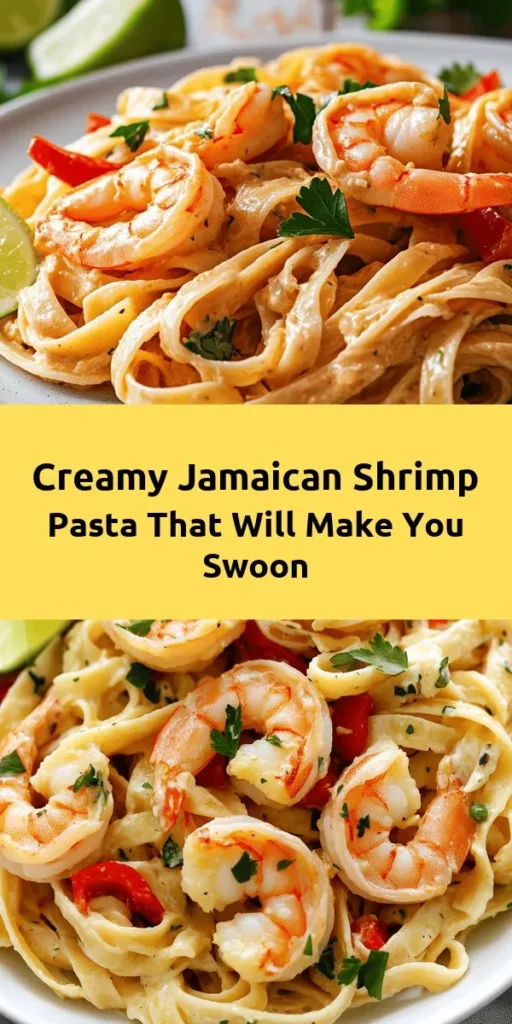Introduction
Caribbean cuisine is renowned for its vibrant flavors, colorful presentations, and the rich cultural tapestry that influences its dishes. Among the myriad of culinary delights that hail from this sun-soaked region, Jamaican flavors stand out with their boldness and complexity. One such dish that embodies this spirit is Jamaican Shrimp Pasta—a recipe that combines the fresh, succulent taste of shrimp with the creamy richness of coconut milk and the spicy kick of jerk seasoning. This dish is not only a feast for the senses but also a journey to a tropical paradise, offering an exquisite blend of textures and tastes that will leave your taste buds dancing with joy.
Jamaican Shrimp Pasta is a unique fusion that reflects the island’s culinary traditions. The creamy sauce, made from coconut milk, seamlessly envelops al dente fettuccine, while the jerk seasoning infuses the shrimp with a depth of flavor that is hard to resist. This recipe is ideal for both novice cooks and seasoned chefs, as it is relatively easy to prepare yet delivers a restaurant-quality meal that can impress any dinner guest.
In this article, we will explore the key ingredients that make this dish a standout, and provide a step-by-step guide to preparing it in your own kitchen. Not only will you learn how to create this delightful meal, but you’ll also uncover the health benefits of its components and tips for achieving the perfect balance of flavor and texture. So, let’s dive into the world of Jamaican Shrimp Pasta and discover what makes it such a beloved dish.
Understanding the Ingredients
Exploration of Fettuccine Pasta
Fettuccine is a type of pasta that is flat, thick, and has a broad shape, which allows it to hold sauces exceptionally well. Originating from Italy, fettuccine is traditionally made from egg and flour, resulting in a rich, chewy texture that complements a variety of sauces. In the context of Jamaican Shrimp Pasta, its ability to embrace the creamy coconut sauce makes it an ideal choice, ensuring that every bite is flavorful and satisfying.
When preparing fettuccine, it’s essential to cook it to an al dente texture—firm to the bite but still tender. This ensures that the pasta can hold up against the sauce without becoming mushy. Additionally, you can explore various types of fettuccine, such as whole wheat or gluten-free versions, to cater to dietary preferences while still enjoying this delightful dish.
Overview of Shrimp
Shrimp is a versatile seafood that offers a mild, slightly sweet flavor, making it a popular choice in many cuisines around the world. Nutritionally, shrimp is low in calories yet high in protein, making it an excellent option for health-conscious eaters. It also contains essential nutrients, including selenium, vitamin B12, and iodine, contributing to overall health and wellbeing.
When selecting shrimp for your Jamaican Shrimp Pasta, it’s crucial to use fresh or properly frozen shrimp. Fresh shrimp should have a firm texture and a mild, ocean-like scent. If using frozen shrimp, ensure it has been thawed properly to maintain its quality. The cooking process is quick, so it’s important to keep an eye on the shrimp to avoid overcooking, which can result in a rubbery texture.
The Role of Coconut Milk
Coconut milk is a staple in Jamaican cuisine, known for its creamy consistency and subtly sweet flavor. It is derived from the flesh of mature coconuts, providing a rich base for many dishes, from curries to desserts. In Jamaican Shrimp Pasta, coconut milk serves as the creamy element that balances the heat from the jerk seasoning, creating a harmonious blend of flavors.
Beyond its culinary appeal, coconut milk is packed with health benefits. It contains medium-chain triglycerides (MCTs), which may aid in weight management and provide quick energy. Additionally, it is a good source of vitamins C, E, and B vitamins, as well as minerals like magnesium and potassium. This makes it not only a delicious addition but also a nutritious one.
Jamaican Jerk Seasoning
Jerk seasoning is the quintessential spice blend of Jamaican cooking, known for its distinctive flavor profile that combines sweet, spicy, and savory elements. The key components of jerk seasoning typically include allspice, thyme, scallions, garlic, ginger, and scotch bonnet peppers, creating a complex mix that can vary in heat and flavor depending on the proportions used.
When incorporated into Jamaican Shrimp Pasta, jerk seasoning elevates the dish, infusing the shrimp with a smoky, spicy flavor that is both aromatic and satisfying. The depth of flavor provided by jerk seasoning is what makes this dish truly special, offering a taste of Jamaica in every bite.
The Importance of Fresh Vegetables
Fresh vegetables play a crucial role in building the flavor foundation of Jamaican Shrimp Pasta. Onions, garlic, and bell peppers are commonly used in this dish to add aromatic depth and a hint of sweetness. Onions provide a savory base, while garlic enhances the overall flavor profile with its pungent, earthy notes. Bell peppers introduce a slight crunch and a pop of color, making the dish visually appealing.
In addition to their flavor contributions, these vegetables offer various nutritional benefits. Onions are rich in antioxidants and may have anti-inflammatory properties, while garlic is known for its immune-boosting effects. Bell peppers are high in vitamins A and C, providing essential nutrients that support overall health. Incorporating these fresh ingredients not only enhances the dish’s flavor but also adds a nutritional boost.
Step-by-Step Preparation
Now that we’ve explored the key ingredients in Jamaican Shrimp Pasta, it’s time to dive into the preparation process. This recipe involves several steps, each designed to enhance the flavors and ensure a satisfying meal. Below, we will provide a detailed walkthrough of the cooking process, ensuring clarity for readers.
Cooking the Pasta
The first step in preparing Jamaican Shrimp Pasta is cooking the fettuccine. Start by bringing a large pot of salted water to a rolling boil. The salt not only seasons the pasta but also enhances its flavor. Once the water is boiling, add the fettuccine and stir to prevent the strands from sticking together.
For perfect pasta, aim to cook it al dente, which typically takes about 8 to 10 minutes depending on the brand and thickness. To test for doneness, taste a strand of pasta—it should be firm yet tender. Before draining the pasta, reserve about a cup of the pasta water. This starchy water will be invaluable later, as it can be added to the sauce to achieve the desired consistency.
Once the pasta is cooked to your liking, drain it in a colander, but do not rinse. Rinsing removes the starch that helps the sauce cling to the pasta. Instead, set the drained pasta aside while you prepare the sauce.
Sautéing Aromatics
While the pasta is cooking, it’s the perfect time to start sautéing the aromatics that will build the flavor base of our dish. In a large skillet or a wok, heat a couple of tablespoons of olive oil over medium heat. Once the oil is shimmering, add diced onions and minced garlic. Sauté them for about 2-3 minutes until the onions become translucent and the garlic is fragrant.
Next, add sliced bell peppers to the skillet. The key to sautéing is to add ingredients based on their cooking time, allowing each component to reach its peak flavor. Cook the bell peppers for an additional 3-4 minutes until they soften slightly but still retain some crunch. This technique enhances the overall flavor and texture of the dish, creating a delicious aroma that fills your kitchen.
Cooking the Shrimp
With the aromatics sautéed to perfection, it’s time to add the star of the dish: the shrimp. Add the fresh or thawed shrimp to the skillet, ensuring they are spread out in a single layer for even cooking. As you add the shrimp, sprinkle the jerk seasoning generously over them, allowing the spices to coat each piece thoroughly.
Cook the shrimp for about 2-3 minutes on one side, then flip them to cook through. The shrimp will turn pink and opaque, indicating they are perfectly cooked. It’s crucial to avoid overcooking the shrimp, as this can lead to a chewy texture. Once the shrimp are done, remove them from the skillet and set them aside, keeping them warm.
In the next part of this recipe, we will focus on creating the creamy sauce that will tie all the elements together and finish assembling the Jamaican Shrimp Pasta, ensuring a dish that is not only delicious but also visually stunning. Stay tuned for the continuation of this culinary adventure!

To create the creamy sauce for Jamaican Shrimp Pasta, start by combining the sautéed shrimp and vegetables with the coconut milk. This combination is essential in achieving the dish’s signature creaminess. When adding the coconut milk, pour it slowly into the pan while stirring gently. This ensures a smooth integration of flavors and helps prevent the sauce from curdling.
Once the coconut milk is in the pan, add the jerk seasoning mix. This is a crucial moment where the flavors of Jamaica begin to shine through. The spices, typically including allspice, thyme, and Scotch bonnet pepper, will meld with the creamy coconut base, creating a rich and fragrant sauce. Allow the mixture to simmer over medium heat, which is vital for thickening the sauce. As it simmers, the flavors deepen and the sauce will reduce slightly, achieving the desired consistency that clings beautifully to the pasta.
Combining Pasta and Sauce
After the sauce has thickened to your satisfaction, it’s time to combine it with the pasta. Make sure your pasta is al dente, as it will continue to cook slightly once mixed with the sauce. Adding the pasta straight from the pot, along with a splash of the pasta cooking water, can help achieve the right sauce consistency. The starchy water not only helps to loosen the sauce if it’s too thick but also creates a silky texture that adheres well to the noodles.
To ensure every strand of pasta is coated with the sauce, gently toss the pasta with the sauce over low heat for a few minutes. This step is crucial for balancing the flavors. Taste and adjust seasoning as necessary. A squeeze of lime juice can elevate the dish, cutting through the richness of the sauce and adding a refreshing zing that brightens the overall flavor profile.
Serving Suggestions
Presenting your Jamaican Shrimp Pasta beautifully can enhance your dining experience. Start by twirling the pasta onto the center of a large, white plate; this allows the vibrant colors of the dish to stand out. Spoon the creamy shrimp sauce generously over the top, ensuring that the shrimp and vegetables are prominently displayed.
Garnishing is key to elevating your dish. A sprinkle of fresh cilantro not only adds a pop of color but also complements the dish’s tropical flavors. If cilantro is not your preference, consider using finely chopped parsley or green onions for a fresh touch. Both options provide a beautiful contrast without overpowering the dish.
Don’t forget the lime wedges! Presenting the dish with lime wedges on the side invites diners to squeeze fresh lime juice over their plate, enhancing the flavors further. For a tropical theme, consider serving the dish with a small side of coconut rice or a fresh salad with tropical fruits, like mango or pineapple, which harmonizes perfectly with the flavors of your pasta.
Nutritional Information
Understanding the nutritional profile of Jamaican Shrimp Pasta is essential for those conscious of their dietary choices. The dish is relatively balanced, offering a good mix of macronutrients.
*Caloric Breakdown*
On average, a serving of Jamaican Shrimp Pasta contains approximately 600-700 calories, depending on the portion size and specific ingredients used. The macronutrient balance typically consists of around 30% carbohydrates, 40% protein, and 30% fats.
Shrimp contributes significantly to the protein content, making it a filling choice for a meal. The pasta adds carbohydrates for energy, while the coconut milk provides healthy fats, particularly medium-chain triglycerides (MCTs), which are known for their potential health benefits.
*Health Benefits of the Ingredients*
The primary ingredients in Jamaican Shrimp Pasta offer various health benefits. Shrimp is a lean protein source, low in calories and high in nutrients like vitamin B12, iodine, and selenium. Coconut milk, while high in calories, is rich in healthy fats that can promote heart health and provide a creamy texture without dairy.
The vegetables, often bell peppers and onions, add fiber, vitamins, and minerals, making this dish not only delicious but also nutritious. However, it’s important to note that shrimp can be a common allergen for some individuals, and those with shellfish allergies should substitute shrimp with chicken or tofu.
Cultural Significance
Jamaican Shrimp Pasta is not just a meal; it reflects a rich cultural tapestry that combines elements of traditional Jamaican cuisine with modern culinary practices. The use of jerk seasoning, with its origins in the marinating techniques of the indigenous Taino people and African influences, highlights Jamaica’s diverse culinary history.
*Historical Context*
Jerk seasoning is a cornerstone of Jamaican cooking, characterized by its smoky flavor and spice. Traditionally used for grilling meats, it has found its way into various dishes, including pasta, showcasing the adaptability of Jamaican cuisine. The incorporation of pasta into Caribbean meals is a modern adaptation, reflecting the global influences that have shaped contemporary Caribbean cooking.
*Modern Adaptations*
In today’s culinary landscape, Jamaican Shrimp Pasta has gained popularity among food enthusiasts and home cooks alike. It embodies the fusion of cultures and flavors, making it a delightful dish that appeals to a wide audience. As more people seek to explore diverse cuisines, this dish serves as an approachable entry point into the vibrant tastes of Jamaica.
Conclusion
Making and enjoying Jamaican Shrimp Pasta is a delightful culinary experience that combines the warmth of Caribbean flavors with the comfort of a creamy pasta dish. The fusion of spices, the richness of coconut milk, and the fresh elements of lime and cilantro create a symphony of tastes that transport you to a tropical paradise with every bite.
This recipe is not only easy to prepare but also versatile, allowing you to experiment with various ingredients or adjust the spice levels to suit your taste. As you embrace this dish, consider exploring more Caribbean recipes to expand your culinary repertoire. The vibrant tastes of Jamaica await you, ready to bring a slice of island life into your kitchen.



